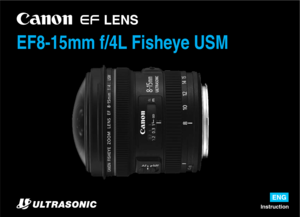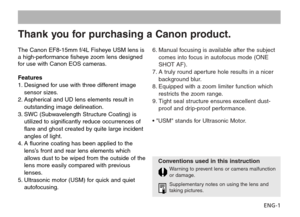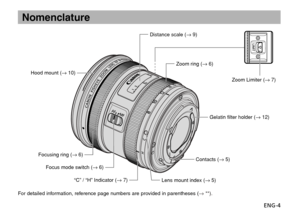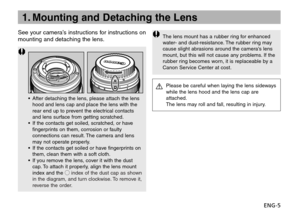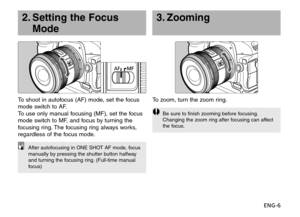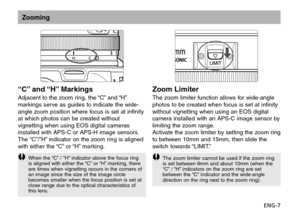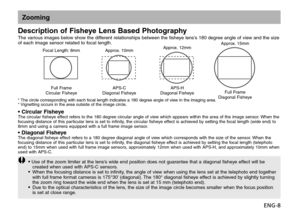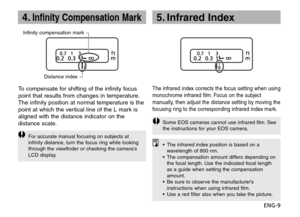Canon 815mm Owners Manual
Here you can view all the pages of manual Canon 815mm Owners Manual. The Canon manuals for Lens are available online for free. You can easily download all the documents as PDF.
Page 2
ENG-1 6. Manual focusing is available after the subject comes into focus in autofocus mode (ONE SHOT AF). 7. A truly round aperture hole results in a nicer background blur. 8. Equipped with a zoom limiter function which restricts the zoom range. 9. Tight seal structure ensures excellent dust- proof and drip-proof performance. • USM stands for Ultrasonic Motor. Conventions used in this instruction Warning to prevent lens or camera malfunction or damage. Supplementary notes on using the lens and taking...
Page 3
ENG-2 aSafety Precautions aSafety Precautions•Do not look at the sun or a bright light source through the lens or camera.Doing so could result in loss of vision. Looking at the sun directly through the lens is especially hazardous. •Whether it is attached to the camera or not, do not leave the lens under the sun without the lens cap attached.This is to prevent the lens from concentrating the sun’s rays, which could cause a fire. Handling Cautions•If the lens is taken from a cold environment into a warm...
Page 4
ENG-3 Precautions for Shooting with a Fisheye Lens •If dirt or dust adheres to the surface of the front lens element, it can easily appear in images due to the lens’s short focal length. In order to avoid this, please remove dirt or dust from the surface of the front lens element by using a commercially available air dust blower. •Since this lens has an extremely wide angle of view, light from bright light sources, such as the sun, can easily enter the image area. Please do not look at bright light...
Page 5
ENG-4 Nomenclature Distance scale (→ 9) Focus mode switch (→ 6) “C” / “H” Indicator (→ 7)Zoom Limiter (→ 7) Lens mount index (→ 5) Contacts (→ 5) Hood mount (→ 10)Zoom ring (→ 6) Focusing ring (→ 6) Gelatin filter holder (→ 12) For detailed information, reference page numbers are provided in parentheses (→**).
Page 6
ENG-5 See your camera’s instructions for instructions on mounting and detaching the lens. •After detaching the lens, please attach the lens hood and lens cap and place the lens with the rear end up to prevent the electrical contacts and lens surface from getting scratched. •If the contacts get soiled, scratched, or have fingerprints on them, corrosion or faulty connections can result. The camera and lens may not operate properly. •If the contacts get soiled or have fingerprints on them, clean them with a...
Page 7
ENG-6 3. Zooming To zoom, turn the zoom ring. Be sure to finish zooming before focusing. Changing the zoom ring after focusing can affect the focus. To shoot in autofocus (AF) mode, set the focus mode switch to AF. To use only manual focusing (MF), set the focus mode switch to MF, and focus by turning the focusing ring. The focusing ring always works, regardless of the focus mode. 2. Setting the Focus Mode After autofocusing in ONE SHOT AF mode, focus manually by pressing the shutter button halfway and...
Page 8
ENG-7 “C” and “H” Markings Adjacent to the zoom ring, the “C” and “H” markings serve as guides to indicate the wide- angle zoom position where focus is set at infinity at which photos can be created without vignetting when using EOS digital cameras installed with APS-C or APS-H image sensors. The “C”/”H” indicator on the zoom ring is aligned with either the “C” or “H” marking. Zoom Limiter The zoom limiter function allows for wide-angle photos to be created when focus is set at infinity without...
Page 9
ENG-8 • Circular FisheyeThe circular fisheye effect refers to the 180 degree circular angle of view which appears within the area of the image sensor. When the focusing distance of this particular lens is set to infinity, the circular fisheye effect is achieved by setting the focal length (wide end) to 8mm and using a camera equipped with a full frame image sensor. • Diagonal FisheyeThe diagonal fisheye effect refers to a 180 degree diagonal angle of view which corresponds with the size of the sensor....
Page 10
ENG-9 4.Infinity Compensation Mark Infinity compensation mark Distance index To compensate for shifting of the infinity focus point that results from changes in temperature. The infinity position at normal temperature is the point at which the vertical line of the L mark is aligned with the distance indicator on the distance scale. For accurate manual focusing on subjects at infinity distance, turn the focus ring while looking through the viewfinder or checking the camera’s LCD display. The infrared...
